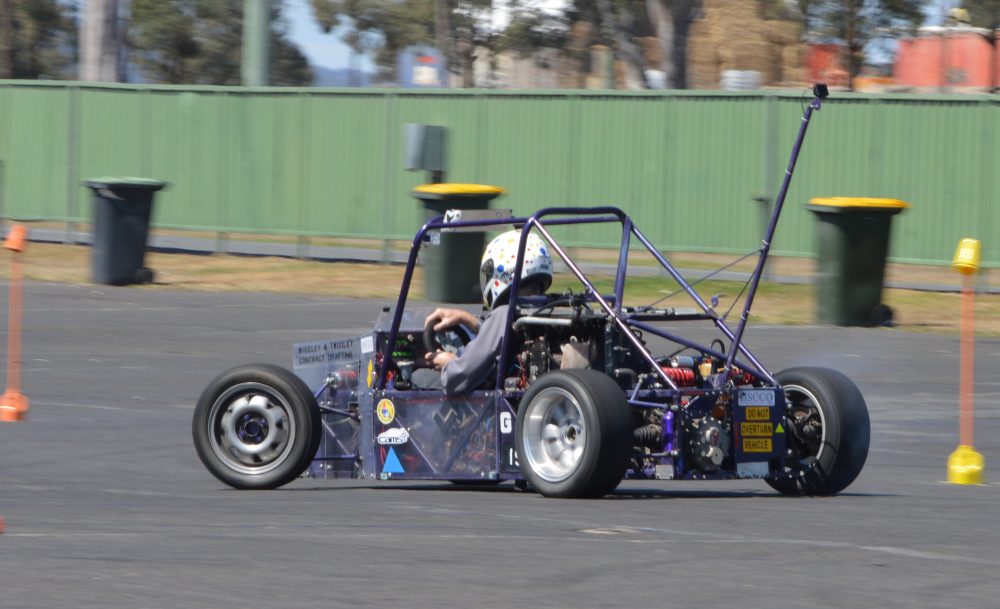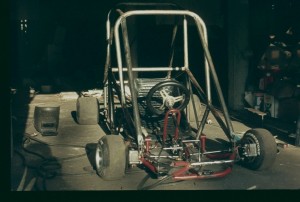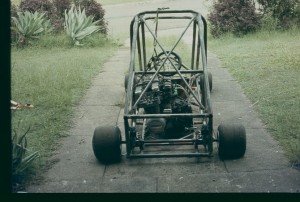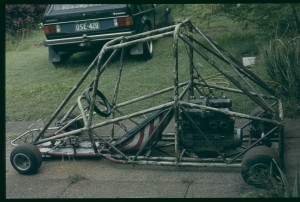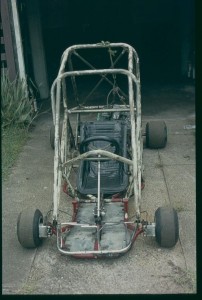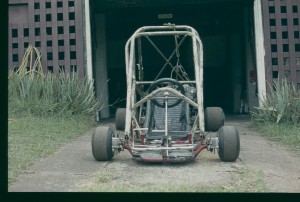KWAKAKART MOTORKHANA SPECIAL.
Brisbane, Queensland, Australia.
Kwakakart is the 5th special built by Alan Wheeley, who started with a clean sheet of paper, and with the then current rules in mind decided to build a rear wheel drive car to be as competitive as the front wheel drive cars. Principal parameters were a vehicle as small as was possible, as light as possible, and as powerful as limited money would allow. Construction was started in August 1982, and the debut of it was on 27th February, 1983 on a dirt surface.
An old circuit racing Go-Kart was purchased to get the wheels, tyres, brakes, hubs, axles etc to keep the vehicle as small as possible. The chassis was modified and lengthened to the minimum wheelbase of 1800 mm, and a full cage incorporated for safety. For power, a Kawasaki Z650 wreck was purchased to get the motor, electrics, exhaust pipes etc. The design of a forward/reverse gearbox was started. This transmission was based on the gears from the bottom leg of an outboard motor (rated at 55 HP), built into a home made casing located in the centre of the rear axle, and fitted with disconnect dog clutches on either side of this transmission. The dog clutches were kept engaged by springs, and disconnected by small air cylinders operated from solenoid valves controlled by switches in the turning brake levers. No suspension was originally incorporated, but corner weights were able to be altered by threaded rods in the cage front mounts. 5 inch diameter wheels front and rear were of 5 inch width at front and 8 inch width at the rear, and fitted with sticky slick tyres. At the time there was a big war between the three tyre manufacturers, and every 6 months a better compound was brought out and nobody then wanted the just superseded compounds, which could be bought for about $20 each. These tyres lasted for about 9 months, and by that time an even newer compound would be on the market.
This car had a motor that revved to 12,500 rpm, it was half the size of the other cars, half the weight, and revved twice as hard. It was spectacular to watch, and not easy to drive. The original kart steering had one quarter of a turn from lock to lock, and this was changed by using some sprockets and chain from a WW2 aeroplane to get it to three quarters of a turn. This chain broke during the Australian Motorkhana Championships in Melbourne in 1983, so the original kart steering was re-fitted. The whole car at this time weighed only 275 kg.
The motor was in the rear, and mounted longitudinally, with the drive taken by chain to the input shaft of the reversing box. All “hot” parts were on the left hand side, with the exhaust system going from 4 into 1 beside the motor, then into a “hot dog” muffler, and then to the rear. To save costs, Alan decided to build this exhaust himself, but realised that the only way he could do it was to buy lots of bends from an exhaust pipe shop, and cut them up and weld them together. So the job was given to a specialist exhaust man, and he did exactly the same thing. All combustibles were on the right hand side of the car. A mower fuel tank fed by gravity to the carburettors, but it was found that cornering forces were so great that the carburettors either starved on left hand turns, or flooded on right hand turns. An electronic fuel pump was then fitted, supplying pressurised fuel to a log manifold in front of the carburettors, with a return line to the tank. Because fuel pressure regulators are expensive, a piece of copper tube was fitted inside the return line, and the tube was bent gradually till the correct fuel pressure was obtained.
The first time the car ran on bitumen was the Mt Cotton Hillclimb on 20th March, 1983. A problem was found in that the return road to the pits was just two strips of concrete, but with a track dimension of less than 1100 millimetres, only two wheels were on the concrete path, and the other two on the rough dirt and rocks between the strips. The result was the whole aluminium floor tray was torn up and destroyed. The next time the car competed at Mt Cotton, it was organised to be allowed to do a spin turn after crossing the finish line, then go back to the pits via the track and start line.
The first bitumen motorkhana was at Rockhampton on 3rd April, 1983 still in its unpainted state, and the photo of some of some of the cars emphasises the size of the car. On the left is a Volkswagen Special, then a Mini Special, then a Citroen Special, then Kwakakart.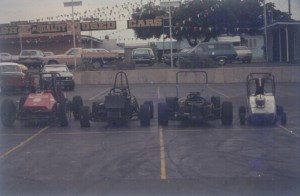
The other photo shows how hard it cornered by lifting the inside rear wheel.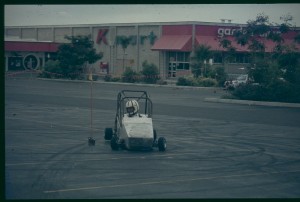
There is videos from that date on youtube. www.youtu.be/isJDjJOFWLw www.youtu.be/wWCYKMKxv9E www.youtu.be/moOxjCzLY5o
The car was painted in June 1983 by Denis Hall. The third Championship Motorkhana it ran in was at Warwick on 3rd July, 1983 where it won outright.
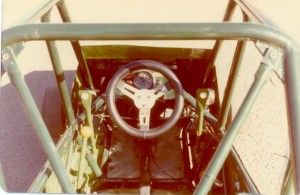
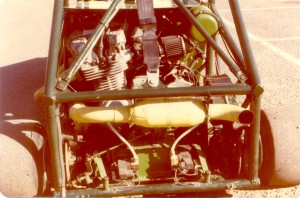
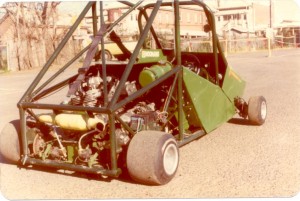
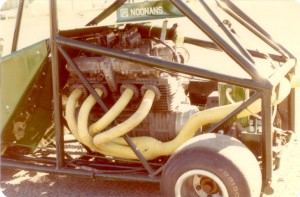 Videos of this event are :- www.youtu.be /aT9eyPMhi2k www.youtu.be/AM_E5G_P_ow
Videos of this event are :- www.youtu.be /aT9eyPMhi2k www.youtu.be/AM_E5G_P_ow
The car was towed to Perth for the 1984 AMC, and won the RWD specials class, but the abrasive surface tore the rear tyres to shreds. It ran again the following weekend (after 5 days towing it back across Australia) at Maroochydore on the Sunshine Coast.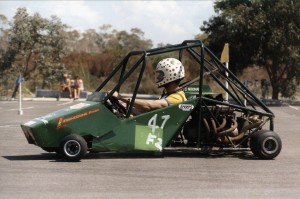
Video is :- www.youtu.be/zA12mAz84E4
When driven hard around corners, the car started to bounce excessively, and after watching a video of the trouble, a solution was found. The rear tyres were gripping until the outside edge lost adhesion, and the car would bounce sideways till the edge gripped again. The rear wheels were then fitted with two front tubes side by side with the inner tube inflated to 20 psi, and the outer to 15 psi. This profiled the tyre slightly, and the bouncing stopped.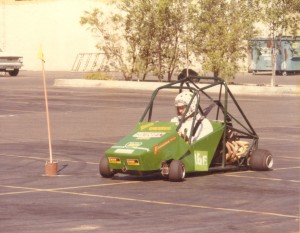
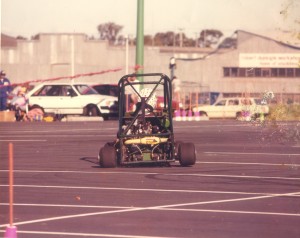
For events on dirt, some 6” diameter wheelbarrow rim halves were fitted with mower tyres that were hand cut to reduce the amount of tread blocks touching the ground, and therefore increase traction. At the Echo Valley Hillclimb at Toowoomba on 28th October, 1984 the speed at the end of the straight was calculated at 130 Kilometres / Hour; which was way above the recommended maximum speed rating for the tyres of 20 KPH.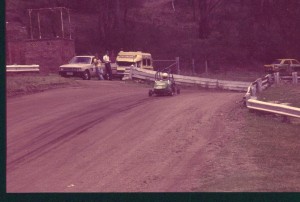
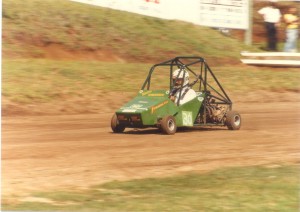 It competed in the 1985 AMC that was held on the gravel at Albury – Wodonga, but the furrows that got to 150 millimetres deep made it difficult to drive a car with only 40 millimetres clearance under the chassis. Video is :- www.youtu.be/LeQUveKxLBQ
It competed in the 1985 AMC that was held on the gravel at Albury – Wodonga, but the furrows that got to 150 millimetres deep made it difficult to drive a car with only 40 millimetres clearance under the chassis. Video is :- www.youtu.be/LeQUveKxLBQ
Unfortunately some of the other competitors did not like anything different from the normal type of car, and steps were put in place to outlaw the car. The car was perfectly legal, so the rules governing motorkhana cars were changed after only three years to make the car ineligible. From now on wheels were to be of a minimum of 10 inches diameter. The car ran a few times in club only motorkhanas, but when the gearbox shredded a spline again, the car was retired to gather dust under the house. www.youtu.be/SBToD6Gz4yU
